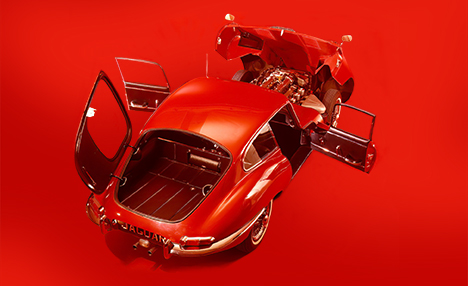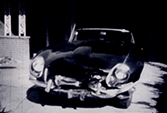When the era of sports cars launched after World War II with the success of the Jaguar XK120 and MG TC, Standard-Triumph wanted in on the market. But the company needed a model that would hold its own in terms of design and performance.

TR2's front end doesn't just have a grille, it has a tunnel that channels the force of air from forward motion into the radiator, cooling the engine. The hot air is expelled through outlets at the windshield end of the hood.
The TR2, which debuted in 1953, possessed not only the formula for a successful model, it established the DNA for the breed: A fast-yet-affordable sports car that often inspired drivers to become racers, and even more often inspired drivers to be long-term owners and collectors.
The Triumph line of sports cars would make heads turn, drivers smile, and racers successful for nearly three decades. Moss technical expert Eric Wilhelm has been driving Triumphs for a long time, and has owned a disassembled 1954 TR2 “long door” since 1984, which he now considers a future retirement project. “What’s great about owning one is that they’re simple, easy to work on, and have good parts availability,” he says.
Yet Wilhelm cautions those thinking of buying one: “They’re fun to drive and have that raw grunt, but they require a high level of driver involvement. Handling can be challenging with stock steering and the stiff suspension.” He adds that they require a lot of maintenance and go downhill fast if not maintained properly.
The Start of It All
Standard-Triumph chief Sir John Black ordered up the two-seater roadster in 1952, but TR1 was the victim of not enough money or time before the October Earls Court Motor Show debut in London. The shape anticipated the TR2, but the back end was stubby and awkward with the spare wheel perched on top. It was underpowered and didn’t handle well.
So Black ordered a redesign and got Ken Richardson, a racer and engineer, to advise. When Richardson initially drove TR1, he proclaimed it “a bloody death trap.” But over a few months with road testing, they redesigned the back end, got a sturdy new chassis, and transformed performance with a four-cylinder, wet-sleeved, 90-bhp engine.
The TR2 prototype appeared at the Geneva Motor Show in March 1953 and received loads of attention. The company decided to make a matching pair of cars, one left-hand drive for the North American shows and one right-hand drive for the European shows. Although hand built, TS1 and TS2 are considered the first TR2 production sports cars. They had pearl white bodies and rear wheel arch covers with geranium-colored interiors.
The TR2 was affordable (less than $2,500) and it was economical (26 mpg). The body design featured arcing lines with integrated fenders and cutaway doors. It seemed to have an automotive personality thanks to the gaping mouth in front and the growling engine. It was simple, solid, and well built.
Most importantly, the TR2 was fast. Richardson easily cruised at 100 mph on the track, and topped 120 mph on the Belgian autobahn near Jabbeke. At the 1954 RAC Rally, TR2s finished first, second, and fifth, and the model finished well at Le Mans the same year.
The TR2 life span was just two years, selling 8,628 units. Model improvements included rocker panels and shortened doors so you could open them without hitting the curb, beefier brakes, optional electric overdrive, radial tires, and liftoff hardtop.
TR3 Enhancements
October 1955 saw the introduction of the TR3. Larger intake ports and larger 1 3/4-inch SU carbs increased power from 90 to 95 hp (although it was countered by greater weight), a flush egg crate-style grille finished off the front end, and chrome beading between fender and body added detailing. Options included an enhanced rear axle ratio and a Laycock de Normanville overdrive.
A host of changes over the next two years included a high-port cylinder head with 100-hp rating, Girling front disc brakes (a first for British cars), and a stronger rear axle. By then, Triumphs dominated in European rallying; in the 1956 Alpine Rally, they took the first five places. They posted a class win at Sebring the same year. Standard-Triumph logged a total of 13,377 TR3s off the production line.
Starting in September 1957, the TR3A, although not an official Triumph designation, featured a broadly grinning grille, more deeply recessed headlights, parking lights set in the corners, larger bumpers, external door and trunk handles, and a trunk lock. There were slight revisions in the body when the tooling was replaced in winter 1960, plus changes in the brakes. By October 1961, 58,326 TR3As had been sold.
The TR3B had a run of 3,331 units before production ended in October 1962, and was the last of the side screen cars. It featured the all-synchronized TR4 gearbox, and the later ones featured TR4’s 2138cc engine rather than TR3’s 1991cc unit.
Maintenance Matters
Wilhelm says that when you maintain a TR2 or 3 according to the book, there aren’t a lot of problems. The bullet connectors in the wiring harness get corroded. The low-tension lead from the distributor to the coil breaks under the insulation probably due to engine vibration, causing the car to sputter and die. Sludge and rust can collect in the cooling system at the back of the block around the number-four cylinder, restricting coolant flow. You can remove the number-four wet liner to check it, he explains.
You’ll need to keep your cooling system flushed and clear; Water Wetter is an inexpensive and easy helper, says Wilhelm. Since the cars are well known for overheating in slow traffic on a hot day and have minimally effective, unshrouded fans, an electric fan is a good idea. You can install this as a pusher fan in front of the radiator if you want to keep the stock fan set up and eliminate the need for further modifications, advises Wilhelm.
TR2s and 3s are also notorious for loose, floppy steering. “The system’s seven pivot points get loose and worn out, and it’s hard to maintain,” explains Wilhelm. “Plus the stock system has zero-degree caster so it’s hard to keep the car going in a straight line even on a straight, flat road.”
A popular solution is to add the rack-and-pinion conversion kit, which takes out steering slop and reduces maintenance hassle, Wilhelm says. It enhances drivability and safety for most drivers. You’ll have to use an electric fan, and replace your turn signal and horn controls when you add this kit.
Either way, you can replace the squishy rubber bushings and pins with Delrin for the original steering drag links, Wilhelm adds. And you can reduce the flexing of your front stub axles with an upgraded front axle kit.
Upgrades That Help
For easier oil changes that don’t get oil in your face or on the floor, go for a spin-on oil filter conversion kit, says Wilhelm. Good air filters are a useful addition since the old wire mesh was more air strainer than filter, he adds.
Reliability is enhanced with a gear reduction starter, says Wilhelm. They start better, crank the engine over faster, and are pretty much your only option when your starter motor goes on TR2 and early 3s since the parts are no longer available for a rebuild.
If your stock Lucas distributor is worn and sloppy, you have repair options: you can mount a PerTronix electronic ignition on your stock Lucas distributor, go for a PerTronix Flame-Thrower electronic distributor, or install a Mallory dual point distributor, Wilhelm explains.
Supercharger Leads Modifications
The hot new product for TR2s and 3s is the supercharger, developed by Moss and launched in October. It offers substantial increases in horsepower and torque. The kit is designed for high-port heads, so any TR2 or 3 owners with the early low-port head would need to convert to a high-port head (choose cast iron, or aluminum; either way an easy bolt-on) when adding the supercharger.
Moss designed the kit to work with 86mm pistons and liners, but can supply pulleys to work with 83mm pistons at additional cost. The 83mm units have been unavailable for some time, so many early cars already sport the 86mm pistons and liners. A boost upgrade kit further enhances the supercharger, says Wilhelm.
Moss Motors’ 1958 TR3A illustrates the supercharger’s benefit. Triumph originally advertised 105 flywheel horsepower at 4,750 rpm on a test bed. When Moss bolted in the supercharger, it hit 120 hp at 4,800 rpm at the rear tires with standard boost (5 psi). With the boost upgrade kit added, the car hit 133.8 hp at 6.7 psi of boost. Torque at the rear tires was measured at 142 lb.-ft. with standard boost, and 153 lb.-ft. with the boost upgrade. These are increases of 40 to 50 percent on an otherwise stock engine.
Part Options to Please
When it comes to carburetors, you can rebuild your old ones with available parts, get a new set of genuine SUs, or go for a pair of Weber side drafts if you have a high-port head. For exhaust, you can choose the stock design made in stainless steel to prevent rust; a Monza sport muffler that increases horsepower and gas mileage by reducing exhaust gas back pressure; or add headers for custom exhaust.
Moss recently designed brake master cylinders that look like the originals yet use modern materials. “There are more parts and accessories for these cars now than there were 20 years ago,” says Wilhelm. “Our offering of stock replacement parts is still expanding.”
TR2 and 3 Popular Replacement Parts
640-020 – Robbins Vinyl Top, Black
642-155 – Leather Front Seat Kit, Black
639-040 – Carpet Kit, Cut Pile, Black
870-040 – Grille
855-740 – Rear Trunk Panel
850-000 – Radiator
593-055 – Clutch Kit, Borg & Beck
856-002 – Windshield, Triplex
860-100 – Stainless Steel Exhaust System
541-515 – Starter, Hi-Torque
851-195 – Leaf Spring
Insider’s Info:
The TR2 and 3 spare wheel stows away flat in its own compartment with a cover holding the license plate; the trunk is downright roomy.
TR2 weighed 1,850 pounds and had a rated top speed of 103 mph. TR3 weighed in at 1,990 pounds with a top speed of 102 mph.
The model designer was Walter Belgrove of Standard-Triumph.
The front windshield could easily be removed for drivers wanting to feel the wind in their face.
The big glove compartment is lockable, seen as a great virtue at the time.
The fuel tank, with fill opening in the center, is located between the seat backs and the trunk.
The TR3 GT kit offered outside door handles and a removable hardtop, and it allowed the car to qualify for Sports and GT rally classes.
TR3 offered an optional “occasional seat,” a bench behind the front seats for someone to essentially sit at right angles to the direction of travel.
If you want an early car to vintage race or autocross, go for a TR3B. It features rarity and disc brakes, and most have the TR4 engine and transmission.
Current market value for a TR2 in good condition is $14,000-$21,000; TR3 is $10,000-$14,000; TR3A is $13,500-$18,500; and TR3B is $13,500-$20,000. Add about $1000 for the matching hardtop. “I think that the standard TR3—non-A car—is the one that is the best buy as it is prettier than a TR3A or B or TR2, and can be had cheaply,” adds Andy Reid, auction editor for Classic Motorsports.
By Kathy Mangan








'TRIUMPH TR2/3: Launch of a Legacy' has 1 comment
July 14, 2012 @ 7:58 pm mike b
Very nice article